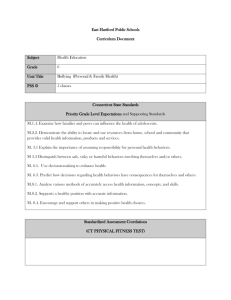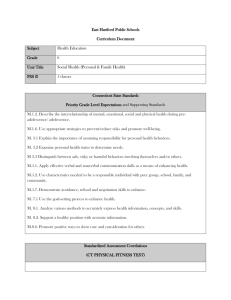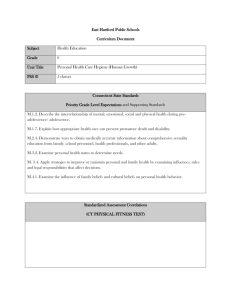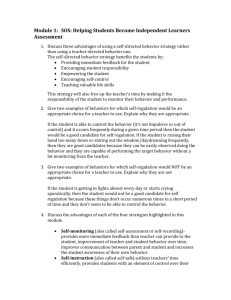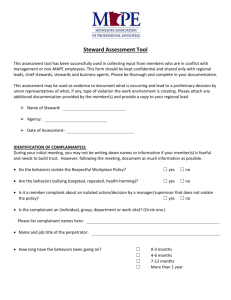East Hartford Public Schools Curriculum Document Subject Health
advertisement
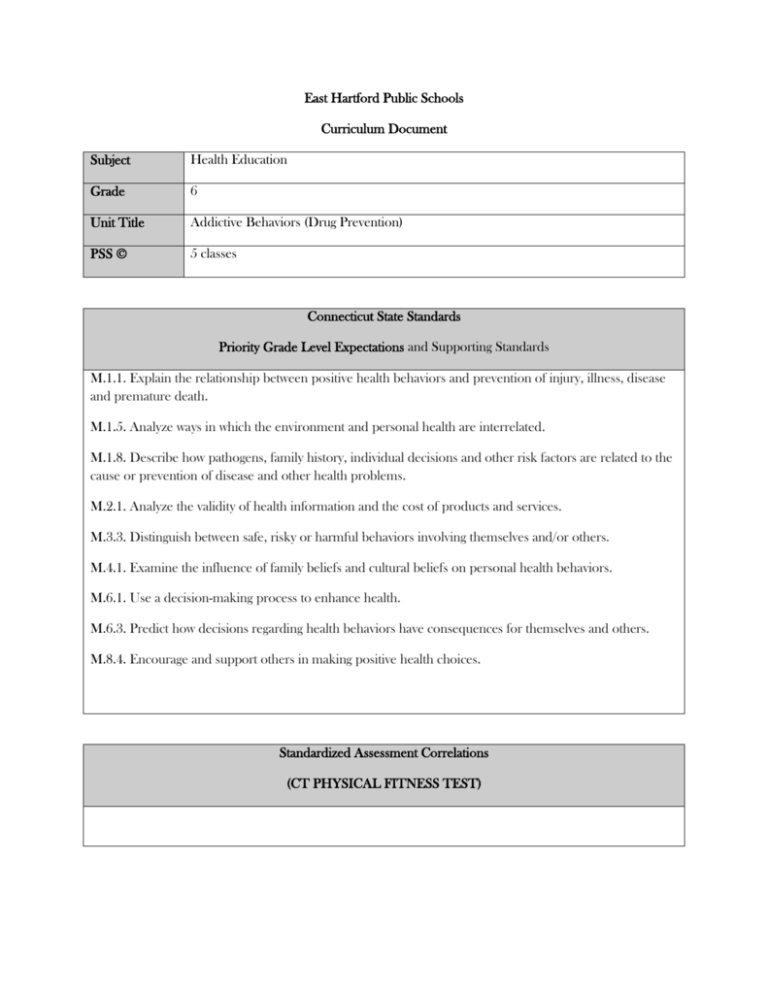
East Hartford Public Schools Curriculum Document Subject Health Education Grade 6 Unit Title Addictive Behaviors (Drug Prevention) PSS © 5 classes Connecticut State Standards Priority Grade Level Expectations and Supporting Standards M.1.1. Explain the relationship between positive health behaviors and prevention of injury, illness, disease and premature death. M.1.5. Analyze ways in which the environment and personal health are interrelated. M.1.8. Describe how pathogens, family history, individual decisions and other risk factors are related to the cause or prevention of disease and other health problems. M.2.1. Analyze the validity of health information and the cost of products and services. M.3.3. Distinguish between safe, risky or harmful behaviors involving themselves and/or others. M.4.1. Examine the influence of family beliefs and cultural beliefs on personal health behaviors. M.6.1. Use a decision-making process to enhance health. M.6.3. Predict how decisions regarding health behaviors have consequences for themselves and others. M.8.4. Encourage and support others in making positive health choices. Standardized Assessment Correlations (CT PHYSICAL FITNESS TEST) Subject Health Education Grade 6 Unit Title Addictive Behaviors (Drug Prevention) PSS © 5 classes Big Ideas Essential Questions The impact of addictive behaviors on overall health. 1. What kinds of behaviors lead to addiction? 2. What are the consequences of addiction? 3. How would a person deal with an addiction? Concepts Skills (what students need to know) (what students need to be able to do) Bloom’s Level Risks of dependence and addiction. Accessing information 2 Relationship between alcohol and other drugs use and mental health. Decision-making 3 Goal setting 3 How to get help for dependence and addiction. Encourage others to make healthful choices. 2-3 Assessments Pre-Assessment “Dipsticks” (Informal Progress Monitoring) As determined by: True/False Unit Content Open-ended response Symbols/charts prior knowledge Collins Writing Types 1-5 Projects & presentations Homework Essays Note checks & Graphic Organizers Data Discussion (CFA’s) (Teachers) Post-Assessment True/False Unit Content Open-ended response Symbols/charts prior knowledge Assessment Guides (Rubrics) To be attached with Unit Assessment. Instructional Planning REQUIRED Resources and Materials Comprehensive School Health Education. Healthy & Balanced Living Curriculum Framework. Connecticut State Department of Education. 2006. Health Education Assessment Project. Curriculum Framework – State of Connecticut. 2003. Recommended Resources and Materials Instructional Drolet, J. & Wycoff-Horn, M. Health Education Teaching Strategies – for Elementary and Middle Grades. American Association for Health Education. 2006. Technological www.healthteacher.com www.kidshealth.org Instructional Planning (continued) Effective Teaching Strategies 1-6-8 Enrichment, Intervention, and Differentiation East Hartford Public Schools Curriculum Document Subject Health Education Grade 6 Unit Title Drug Use & Abuse (Drug Prevention) PSS © 5 classes Connecticut State Standards Priority Grade Level Expectations and Supporting Standards M.1.1. Explain the relationship between positive health behaviors and prevention of injury, illness, disease and premature death. M.1.5. Analyze ways in which the environment and personal health are interrelated. M.1.8. Describe how pathogens, family history, individual decisions and other risk factors are related to the cause or prevention of disease and other health problems. M.2.1. Analyze the validity of health information and the cost of products and services. M. 3.1 Explain the importance of assuming responsibility for personal health behaviors. M 3.3 Distinguish between safe, risky or harmful behaviors involving themselves and/or others. M.6.1. Use a decision-making process to enhance health. M.6.3. Predict how decisions regarding health behaviors have consequences for themselves and others. M.8.4. Encourage and support others in making positive health choices. Standardized Assessment Correlations (CT PHYSICAL FITNESS TEST) Subject Health Education Grade 6 Unit Title Drug Use & Abuse (Drug Prevention) PSS © 5 classes Big Ideas Essential Questions 1. What are the health risks of improper drug use? 2. What are behaviors that lead to drug use and abuse? 3. What positive roles do drugs play in our society? There are negative and positive consequences of taking drugs and/or medications. Concepts Skills (what students need to know) (what students need to be able to do) Physical, social, and emotional effects of alcohol and other drugs use. Signs and behavior of alcohol and other drugs use. Benefits of not using alcohol and other drugs (physical, social, emotional, financial, legal). Accessing information Bloom’s Level 2 Decision-making 2-3 Goal setting 3-4 Demonstrate communication among individuals. 2-3 Demonstrate refusal skills. 3 Assessments Pre-Assessment “Dipsticks” (Informal Progress Monitoring) As determined by: True/False Unit Content Open-ended response Symbols/charts prior knowledge Collins Writing Types 1-5 Projects & presentations Homework Essays Note checks & Graphic Organizers Data Discussion (CFA’s) (Teachers) Post-Assessment True/False Unit Content Open-ended response Symbols/charts prior knowledge Assessment Guides (Rubrics) To be attached with Unit Assessment. Instructional Planning REQUIRED Resources and Materials Comprehensive School Health Education. Healthy & Balanced Living Curriculum Framework. Connecticut State Department of Education. 2006. Health Education Assessment Project. Curriculum Framework – State of Connecticut. 2003. Recommended Resources and Materials Instructional Drolet, J. & Wycoff-Horn, M. Health Education Teaching Strategies – for Elementary and Middle Grades. American Association for Health Education. 2006. Technological www.healthteacher.com www.kidshealth.org Instructional Planning (continued) Effective Teaching Strategies 1-2-8 Enrichment, Intervention, and Differentiation East Hartford Public Schools Curriculum Document Subject Health Education Grade 6 Unit Title Tobacco (Drug Prevention) PSS © 5 classes Connecticut State Standards Priority Grade Level Expectations and Supporting Standards M.1.1. Explain the relationship between positive health behaviors and prevention of injury, illness, disease and premature death. M.1.5. Analyze ways in which the environment and personal health are interrelated. M.1.8. Describe how pathogens, family history, individual decisions and other risk factors are related to the cause or prevention of disease and other health problems. M.2.1. Analyze the validity of health information and the cost of products and services. M. 3.1 Explain the importance of assuming responsibility for personal health behaviors. M 4.2 Analyze how media, technology and other factors influence personal health behaviors. Standardized Assessment Correlations (CT PHYSICAL FITNESS TEST) Subject Health Education Grade 6 Unit Title Tobacco (Drug Prevention) PSS © 5 classes Big Ideas You can prevent diseases and death by not smoking. Essential Questions 1. Why do adolescents start to smoke? 2. What are the effects of smoking? 3. What are the benefits of being tobacco free? Concepts Skills (what students need to know) (what students need to be able to do) Physical, social, and emotional effects of alcohol and other drugs use. Identify and analyze internal and external factors on health. How to accept personal responsibility for choices about alcohol and other drugs use. Address interrelationships and complexity of influences. Influences different levels of alcohol and other drugs use. Decision-making Internal, family, and peer influences. Advertising and media strategies and influences. How to make a personal commitment to not use. Bloom’s Level 1-4 4-5 3 Assessments Pre-Assessment “Dipsticks” (Informal Progress Monitoring) As determined by: Collins Writing Types 1-5 Projects & presentations Homework Essays Note checks & Graphic Organizers Data Discussion (CFA’s) (Teachers) True/False Unit Content Open-ended response Symbols/charts prior knowledge Post-Assessment True/False Unit Content Open-ended response Symbols/charts prior knowledge Assessment Guides (Rubrics) To be attached with Unit Assessment. Instructional Planning REQUIRED Resources and Materials Recommended Resources and Materials Comprehensive School Health Education. Healthy & Balanced Living Curriculum Framework. Connecticut State Department of Education. 2006. Instructional Drolet, J. & Wycoff-Horn, M. Health Education Health Education Assessment Project. Curriculum Framework – State of Connecticut. 2003. Education. 2006. Teaching Strategies – for Elementary and Middle Grades. American Association for Health Technological www.healthteacher.com www.kidshealth.org Instructional Planning (continued) Effective Teaching Strategies 6-1-5 Enrichment, Intervention, and Differentiation
